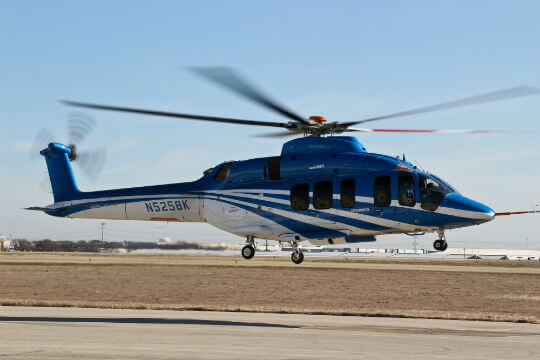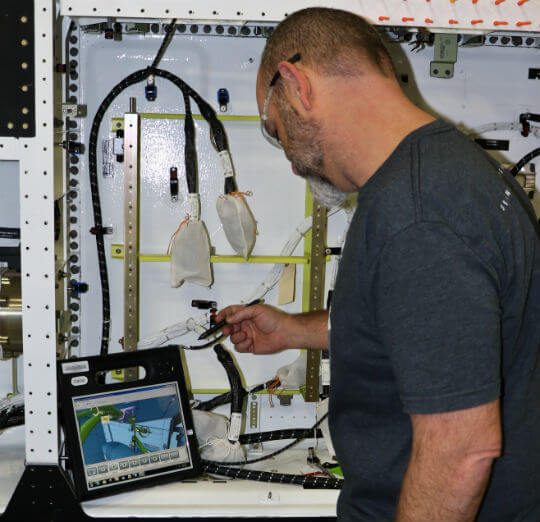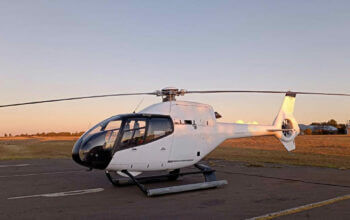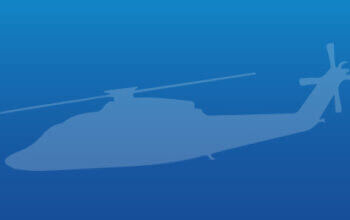
Ship number two departs for a test flight. Over 130 flight hours have been accumulated between test ships number one and two.
It’s been a little over five years since Bell Helicopter began the conceptual phase for a clean-sheet, medium-class helicopter that could do the work of a heavy-class ship. This effort was publicly unveiled at Heli-Expo 2012, with the announcement of the launch of the 525 Relentless program.
This 20,000-pound gross weight class helicopter offers a standard seating configuration for 16 passengers and two pilots, and a typical cruise speed in the 155-knot realm for distances of over 500 nautical miles. To create it, Bell is employing some of the most advanced systems ever incorporated into the design and building of a commercial helicopter.
The Bell 525 will be the first ever commercial fly-by-wire (FBW), civil certified part 29 helicopter. With certification expected during the latter half of next year, and over 130 hours in the flight test logbooks, Bell invited Vertical to its headquarters in Fort Worth, Texas, to see how the aircraft’s development was progressing first-hand.
The day began with a visit to the Arlington, Texas, XworX facility to watch the 525 fly, followed by an opportunity to fly the Relentless Advanced Systems Integration Lab (RASIL) 525 simulator. The day concluded with an afternoon flight in the company Citation to the brand new 525 production facility in Amarillo, Texas, where the assembly line was busy building additional 525s for certification testing, as well as the first run of production ships for customer delivery.
No matter how many mock-ups one might sit in and walk around during the early stages of any design, there is nothing like walking up to the real thing. The sleek design of the 525 exterior masks the voluminous cockpit and cabin section. Behind the main cabin I observed a technician easily working in another large open area. I asked James Harris, integrated production team (IPT) lead in aircraft test and evaluation, what will eventually go in that area. “Baggage,” he responded. “That’s just one of the advantages of the 525 design, [with] all of the major systems components above the cabin.” This will also facilitate the smoothest ride of any Bell aircraft, since 95 percent of any vibration source will be captured above the cabin through a multi-faceted vibration isolation system designed to catch vibration before it reaches the cabin.

Technicians prepping a flight test ship for another flight. Notice the baggage area being large enough to kneel in.
And speaking of components, the 525 features triple redundancy for all major systems. “The 525 was the first helicopter designed for maximum gross weight flight — including performance class 2E category A take-offs — without compromising safety,” stated Larry Thimmesch, VP, 525 sales.
“Bell’s focus was on innovation and above all, safety. Triple redundancy on all major systems such as electrical, hydraulics, and actuators means one system can fail and the mission can be continued normally. FBW technology, of which Bell has decades of experience with in the V22, has driven this new level of safety.”
Certainly, the Bell 525 is a complex helicopter. But its design goal is to enhance safety through simplicity. Just a few of the benefits of the FBW system include: side-stick controls providing closer access to displays; tactile limit queuing, in which the stick alerts the pilot when limits are being approached; basic ship automatic approach to hover, auto-hover capability and automated departure profiles; full-time, high-integrity gust alleviation and stability augmentation.
My return to the sim felt like home. “The sim turned out to be very accurate in predicting how the actual 525 would fly,” said Larry Roberts, a 525 sales VP. I quickly refreshed myself on the fact that as a 525 pilot, less is more. The cyclic and collective controls are more like video game controllers where for the best results, you merely bend your wrist or tap a trim switch to suggest to the 525 what you want it to do and then let the helicopter handle it.
Most impressive to me on this sim session was when both engines were failed and the 525 immediately assumed an autorotative descent at about 85 knots and 103 percent rotor RPM. (Bell is still tweaking the final numbers for these parameters.) While you’re experiencing the “This can’t be happening to me” reaction, the 525 is already doing the right thing.

The author sampling some of the latest features of the 525 in the RASIL simulator.
As impressive as all of the above was, what really hit home for me on this visit was how seamlessly the latest in computer technology integrates the 525’s design, production, pilot operation, and maintenance. It all came together during the visit to the new production facility. Bell 525 assembly manager, Dave Dennison, provided a very detailed tour of 525s in various stages of the build process.
Flight test ship number 3 (which is due to be placed into service by April,) was going through systems checks in preparation for its visit to the paint shop. Other airframes were in various stages of production and mounted on rotating precision Kuka machines — all computer controlled.
Dennison reported that the accuracy of the tooling to airframe interface is measured in thousands of an inch. “The ships are identical in production,” he stated. “The holes are drilled and we can match skins and drop in bolts with no need for shims.” The production process is designed to minimize the need for actual hand work on the line. “The guys on the line say it’s like putting Lego together,” said Thimmesch.
There is no riveting or cutting — it’s all composites and screws. This explained why, when I entered the spotless facility, my first thought was that the workers must be on a break. The floor was very quiet.
If a design change is implemented on the engineers CAD, it’s immediately sent to the line and picked up at the first available airframe. It was interesting to watch the assembly technicians perform their tasks while referring to tablets. (I couldn’t find paper schematics lying around anywhere.) A closer look at the tablet screen revealed 3-D animated renderings showing the installation steps for the task at hand. The pages can be viewed frame by frame or in full motion. In my case, the animation was providing an up close and personal trip through the airframe following a wire bundle path.

On the production line, all installation instructions are on a tablet including 3-D motion renderings.
It’s interesting to note that the same type of tablet-based system will be provided to maintenance technicians in the field. Instead of cumbersome paper manuals, field technicians will now refer to the Integrated Electronic Technical Manual (IETM). This is a light software based system (internet connection not required) that provides the actual specific aircraft serial number “as-built” information. This includes any production line changes as noted above, along with whatever options and/or kits that were installed. So even though there are many common systems to each helicopter, the electronic maintenance manual that accompanies each aircraft is indeed unique to that specific aircraft.
And it gets better. Imagine the 525 being out on a trip and the ship’s computers sense a system anomaly through the thousands of inputs it constantly evaluates. First, when it comes to major systems (of which there are three; all identical), the aircraft can diagnose the issue based on voting rights. You have one system that’s not comparing to two others, which makes it much easier to confirm the problem.
The aircraft then goes through a four-to-five layer set of protocols to determine the criticality of the problem and whether the pilot needs to be involved. With over 200 parameters to consider, the aircraft is so smart that it knows whether it’s an immediate issue that flags the pilot and gets transmitted back to base, or if it can wait until the end of the flight or the day. And there are various levels of obtaining the data, from a quick five minute download to a full data dump of raw data.
From this point, the technician consults the IETM, which gives him or her virtual instructions on the issue and what to do to resolve it. It’s like having a 3-D YouTube video showing you how to perform the task. Additionally, when the problem part is located, the graphics can be manipulated to show how it’s removed, what tools are needed, and with a click on that part, that part number is sent to the company’s designated purchasing agent for ordering. And I was told this system is designed to integrate with the various commercial maintenance tracking programs in use by many operators.

Production line technician checking a wire bundle installation. Note that the cabin is rotated on its side for easier access for the technicians.
Of course, the 525 needs to get into the operators hands so they can take advantage of these technological advances in operation and support. Test ship number 3 is the last of the “prototype” aircraft, joining ships 1 and 2 in the Federal Aviation Administration (FAA) certification effort. Ships 4 and 5 will be built in the final production configuration and used for FAA certification flight testing, but will also include all 52 kits that are to be certified along with the aircraft. Full ice protection is in the plans, but not in conjunction with initial certification work.
Concurrent with the work towards certification is the production of a full-motion flight simulator that will be based at the new Bell Training Academy in Fort Worth. “We want to have the 525 sim in full service to start training at least six months in advance of when we start delivering the actual helicopters,” said Thimmesch. Roberts added: “With all the data sets and control laws we have from the RASIL, as well as flight testing, we have a good leg up on having that sim being accurate and in place on schedule.”
One thing all of the computer technology can’t resolve is the depressed oil-and-gas (O&G) market the industry is experiencing, and its impact on that segment’s helicopter sales. Bell originally targeted O&G as the launch market for the 525, so had to make some adjustments on their production planning. “We will be at an ebb of the O&G market when the 525 enters service,” said Thimmesch. “So we are currently building to the corporate and VIP market, which has turned out to be much stronger segment for 525 sales than we anticipated.”

Flight test ship number three is going through a final series of systems checks before proceeding to the paint shop and then placed into service.
Case in point is that the launch customer has now shifted to Abu Dhabi Aviation, which has ordered 10 525s to be used for corporate, VIP, and O&G support. (In fact, there was another corporate customer in town during our visit to spec out their interior.) “Although the current market is tough, we’ve seen this situation many times before and we are confident that the capabilities of the 525 will turn our 79 letters of intent into contracts,” said Thimmesch. “We’re just at the starting point.”
The Bell 525 Relentless is a highly anticipated helicopter — and for good reason. The helicopter is testing out to be fast, smooth, and with minimal surprises. The FBW system means the new owners are investing in tomorrow’s technology rather than yesterdays.
In the roughly 130 flight test hours performed thus far, Bell is actually 40 percent ahead of schedule in specific test points to be accomplished — another big advantage of the early RASIL program. This should result in certification testing beginning a bit ahead of schedule. For many, the trip from initial computer concept to testing, certification and ultimately becoming a familiar sight in the sky can’t come fast enough.








